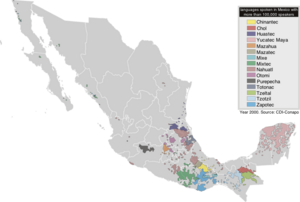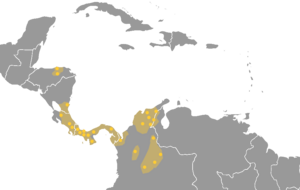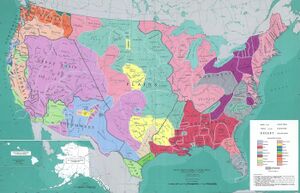Social:Classification of indigenous languages of the Americas
This is a list of different language classification proposals developed for the indigenous languages of the Americas. The article is divided into North, Central, and South America sections; however, the classifications do not correspond to these divisions.



North America
Glottolog 4.1 (2019)
Glottolog 4.1 (2019) recognizes 42 independent families and 31 isolates in North America (73 total).[1] The vast majority are (or were) spoken in the United States, with 26 families and 26 isolates (52 total).
- North American languages families proposed in Glottolog 4.1
|
|
Gallatin (1836)
An early attempt at North American language classification was attempted by A. A. Albert Gallatin published in 1826, 1836, and 1848. Gallatin's classifications are missing several languages which are later recorded in the classifications by Daniel G. Brinton and John Wesley Powell. (Gallatin supported the assimilation of indigenous peoples to Euro-American culture.)
- (Current terminology is indicated parenthetically in italics.)
Families
- Algonkin-Lenape (=Algonquian)
- Athapascas (=Athabaskan)
- Catawban (=Catawba + Woccons)
- Eskimaux (=Eskimoan)
- Iroquois (=Northern Iroquoian)
- Cherokees (=Southern Iroquoian)
- Muskogee (=Eastern Muskogean)
- Chahtas (=Western Muskogean)
- Sioux (=Siouan)
Languages
|
11. Straits of Fuca (=Makah) |
Gallatin (1848)
Families
- Algonquian languages
- Athabaskan languages
- Catawban languages
- Eskimoan languages
- Iroquoian languages (Northern)
- Iroquoian languages (Southern)
- Muskogean languages
- Siouan languages
Languages
|
1. Adai |
18. Kutchin |
Powell's (1892) "Fifty-eight"
John Wesley Powell, an explorer who served as director of the Bureau of American Ethnology, published a classification of 58 "stocks" that is the "cornerstone" of genetic classifications in North America. Powell's classification was influenced by Gallatin to a large extent.
John Wesley Powell was in a race with Daniel G. Brinton to publish the first comprehensive classification of North America languages (although Brinton's classification also covered South and Central America). As a result of this competition, Brinton was not allowed access to the linguistic data collected by Powell's fieldworkers.
- (More current names are indicated parenthetically.)
|
1. Adaizan |
21. Keresan |
40. Shoshonean (=Uto-Azetcan) |
Rivet (1924)
Paul Rivet (1924) lists a total of 46 independent language families in North and Central America. Olive and Janambre are extinct languages of Tamaulipas, Mexico.[2]
|
|
Sapir (1929): Encyclopædia Britannica
Below is Edward Sapir's (1929) famous Encyclopædia Britannica classification. Note that Sapir's classification was controversial at the time and it additionally was an original proposal (unusual for general encyclopedias). Sapir was part of a "lumper" movement in Native American language classification. Sapir himself writes of his classification: "A more far-reaching scheme than Powell's [1891 classification], suggestive but not demonstrable in all its features at the present time" (Sapir 1929: 139). Sapir's classifies all the languages in North America into only 6 families: Eskimo–Aleut, Algonkin–Wakashan, Nadene, Penutian, Hokan–Siouan, and Aztec–Tanoan. Sapir's classification (or something derivative) is still commonly used in general languages-of-the-world type surveys. (Note that the question marks that appear in Sapir's list below are present in the original article.)
- "Proposed Classification of American Indian Languages North of Mexico (and Certain Languages of Mexico and Central America)"
|
I. Eskimo–Aleut II. Algonkin–Wakashan
III. Nadene
IV. Penutian
|
V. Hokan–Siouan
|
VI. Aztec–Tanoan
|
Voegelin & Voegelin (1965): The "Consensus" of 1964


The Voegelin & Voegelin (1965)[3] classification was the result of a conference of Americanist linguists held at Indiana University in 1964. This classification identifies 16 main genetic units.
|
6. Penutian phylum
7. Aztec–Tanoan phylum
8. Keres |
Chumashan, Comecrudan, and Coahuiltecan are included in Hokan with "reservations". Esselen is included in Hokan with "strong reservations". Tsimshian and Zuni are included in Penutian with reservations.
Campbell & Mithun (1979): The "Black Book"
Campbell & Mithun's 1979 classification is more conservative, since it insists on more rigorous demonstration of genetic relationship before grouping. Thus, many of the speculative phyla of previous authors are "split".
Goddard (1996), Campbell (1997), Mithun (1999)
(preliminary)
Classification by Goddard (1996), Campbell (1997), Mithun (1999)
|
|---|
|
Families
Isolates
Stocks
The unity of Penutian languages outside Mexico is considered probably by many linguists:
Siouan–Yuchi "probable"; Macro-Siouan likely:
Natchez–Muskogean most likely of the Gulf hypothesis
Hokan: most promising proposals
"Unlikely" to be Hokan:
|
Subtiaba–Tlapanec is likely part of Otomanguean (Rensch 1977, Oltrogge 1977).
Aztec–Tanoan is "undemonstrated"; Mosan is a Sprachbund.
Mesoamerica
(Consensus conservative classification)
Families
- Uto-Aztecan (Other branches outside Mesoamerica. See North America) languages
- Corachol (Cora–Huichol)
- Aztecan (Nahua–Pochutec)
- Totonac–Tepehua
- Otomanguean
- Tequistlatec-Jicaque
- Mixe–Zoque
- Mayan
- Misumalpan (Outside Mesoamerica proper. See South America)
- Chibchan (Outside Mesoamerica proper. See South America)
Isolates
Proposed stocks
- Hokan (see North America)
- Macro-Mayan (Penutian affiliation now considered doubtful.)
- Totonac–Tepehua
- Huave
- Mixe–Zoque
- Mayan
South America
Notable early classifications of classifications of indigenous South American language families include those by Filippo Salvatore Gilii (1780–84),[4] Lorenzo Hervás y Panduro (1784–87),[5][6] Daniel Garrison Brinton (1891),[7] Paul Rivet (1924),[2] John Alden Mason (1950),[8] and Čestmír Loukotka (1968).[9] Other classifications include those of Jacinto Jijón y Caamaño (1940–45),[10] Antonio Tovar (1961; 1984),[11][12] and Jorge A. Suárez (1974).[13][14]
Glottolog 4.1 (2019)
Glottolog 4.1 (2019) recognizes 44 independent families and 64 isolates in South America.[1]
- South American languages families proposed in Glottolog 4.1
|
|
Rivet (1924)
Paul Rivet (1924) lists 77 independent language families of South America.[2]
Mason (1950)
Classification of South American languages by J. Alden Mason (1950):[8]
Classification of South American languages by Mason (1950)
|
|---|
|
Loukotka (1968)
Čestmír Loukotka (1968) proposed a total of 117 indigenous language families (called stocks by Loukotka) and isolates of South America.[9]
|
|
|
Kaufman (1990)
Families and isolates
Terrence Kaufman's classification is meant to be a rather conservative genetic grouping of the languages of South America (and a few in Central America). He has 118 genetic units. Kaufman believes for these 118 units "that there is little likelihood that any of the groups recognized here will be broken apart". Kaufman uses more specific terminology than only language family, such as language area, emergent area, and language complex, where he recognizes issues such as partial mutual intelligibility and dialect continuums. The list below collapses these into simply families. Kaufman's list is numbered and grouped by "geolinguistic region". The list below is presented in alphabetic order. Kaufman uses an anglicized orthography for his genetic units, which is mostly used only by himself. His spellings have been retained below.[15]
|
Families:
|
Isolates or unclassified:
|
Stocks
In addition to his conservative list, Kaufman list several larger "stocks" which he evaluates. The names of the stocks are often obvious hyphenations of two members; for instance, the Páes-Barbakóa stock consists of the Páesan and Barbakóan families. If the composition is not obvious, it is indicated parenthetically. Kaufman puts question marks by Kechumara and Mosetén-Chon stocks.
"Good" stocks:
- Awaké–Kaliana (Arutani–Sape)
- Chibcha–Misumalpa
- Ezmeralda–Jaruro
- Jurí–Tikuna
- Kechumara (=Kechua + Haki) (good?)
- Lule–Vilela
- Mosetén–Chon (good?)
- Páes–Barbakóa
- Pano–Takana
- Sechura–Katakao
- Wamo–Chapakúra
"Probable" stocks:
- Macro-Je (=Chikitano + Boróroan + Aimoré + Rikbaktsá + Je + Jeikó + Kamakánan + Mashakalían + Purían + Fulnío + Karajá + Ofayé + Guató)
- Mura–Matanawí
"Promising" stocks:
- Kaliánan (=Awaké + Kaliana + Maku)
"Maybe" stocks:
- Bora–Witoto
- Hívaro–Kawapana
- Kunsa–Kapishaná (now abandoned)
- Pukina–Kolyawaya
- Sáparo–Yawa
Clusters and networks
Kaufman's largest groupings are what he terms clusters and networks. Clusters are equivalent to macro-families (or phyla or superfamilies). Networks are composed of clusters. Kaufman views all of these larger groupings to be hypothetical and his list is to be used as a means to identify which hypotheses most need testing.
Campbell (2012)
Lyle Campbell (2012) proposed the following list of 53 uncontroversial indigenous language families and 55 isolates of South America – a total of 108 independent families and isolates.[14] Language families with 9 or more languages are highlighted in bold. The remaining language families all have 6 languages or fewer.
|
|
Campbell (2012) leaves out the classifications of these languages as uncertain.
- Boran – Brazil, Colombia
- Esmeralda – Ecuador
- Guamo – Venezuela
- Leko – Bolivia
- Mure – Bolivia
- Puinave – Colombia, Venezuela
Jolkesky (2016)
Jolkesky (2016) lists 43 language families and 66 language isolates (and/or unclassified languages) in South America – a total of 109 independent families and isolates.[16]:783–806
- † = extinct
|
|
|
All of the Americas
Swadesh (1960 or earlier)
Morris Swadesh further consolidated Sapir's North American classification and expanded it to group all indigenous languages of the Americas in just 6 families, 5 of which were entirely based in the Americas.[17]
- Vasco-Dene languages included the Eskimo–Aleut, Na-Dene, Wakashan and Kutenai families along with most of the languages of Eurasia.
- Macro-Hokan roughly comprised a combination of Sapir's Hokan–Siouan and Almosan families and expanded into Central America including the Jicaque language.
- Macro-Mayan comprising Mayan along with Sapir's Penutian and Aztec-Tanoan families, the Otomanguean languages and various languages of Central and South America including the Chibchan languages, the Paezan languages and the Tucanoan languages.
- Macro-Quechua comprising the Zuni language, the Purépecha language and various languages of South America including Quechua, the Aymara language, the Panoan languages and most of the various other languages of Patagonia and the Andes.
- Macro-Carib, an almost entirely South American family including the Carib languages, the Macro-Je languages and the Jirajara languages, albeit including some Caribbean languages.
- Macro-Arawak, a family primarily confined to South America and its component families included the Arawakan languages and the Tupian languages. However, it also was proposed to include the Taíno language in the Caribbean and the Timucua language in Florida.
Greenberg (1960, 1987)
Joseph Greenberg's classification[18] in his 1987 book Language in the Americas is best known for the highly controversial assertion that all North, Central and South American language families other than Eskimo–Aleut and Na-Dene including Haida, are part of an Amerind macrofamily. This assertion of only three major American language macrofamilies is supported by DNA evidence,[19] although the DNA evidence does not provide support for the details of his classification.
Amerind macrofamily proposed by Greenberg
|
|---|
|
Mixed languages
In American Indian Languages: The Historical Linguistics of Native America, Lyle Campbell describes various pidgins and trade languages spoken by the indigenous peoples of the Americas.[20] Some of these mixed languages have not been documented and are known only by name.
- Medny Aleut (Copper Island Aleut)
- Chinook Jargon
- Broken Slavey (Slavey Jargon)
- Loucheux Jargon
- Michif (French Cree, Métis, Metchif)
- Broken Oghibbeway (Broken Ojibwa)
- Basque-Algonquian Pidgin (spoken by the Basques, Micmacs, and Montagnais in eastern Canada)
- Delaware Jargon
- Pidgin Massachusett
- Jargonized Powhatan
- Lingua Franca Creek
- Lingua Franca Apalachee
- Mobilian Jargon
- Güegüence-Nicarao (formerly spoken in Nicaragua)
- Carib Pidgin or Ndjuka-Amerindian Pidgin (Ndjuka-Trio)
- Carib Pidgin-Arawak mixed language
- Media Lengua
- Catalangu
- Callahuaya (Machaj-Juyai, Kallawaya)
- Nheengatú or Lingua Geral Amazonica ("Lingua Boa," Lingua Brasílica, Lingua Geral do Norte)
- Lingua Geral do Sul or Lingua Geral Paulista (Tupí Austral)
- Labrador Eskimo Pidgin
- Hudson Strait Pidgin Eskimo (spoken from 1750–1850)
- Nootka Jargon (18th–19th centuries; later replaced by Chinook Jargon)
- Trader Navajo
- Yopará (Guaraní-Spanish pidgin)
- Afro-Seminole Creole (variety of Gullah)
- Haida Jargon
- Kutenai Jargon
- Guajiro-Spanish mixed language
Lingua francas
- Ocaneechi (spoken in Virginia and the Carolinas in early colonial times)
- Tuscarora language
- Plains sign language
Linguistic areas
See also
- Indigenous languages of South America
- List of extinct languages of South America
- Extinct languages of the Marañón River basin
- List of extinct Uto-Aztecan languages
- List of unclassified languages of South America
- Classification of indigenous peoples of the Americas
- Classification of Southeast Asian languages
- Intercontinental Dictionary Series
Notes and references
- ↑ 1.0 1.1 Hammarström, Harald; Forkel, Robert; Haspelmath, Martin, eds (2019). "Glottolog". Jena: Max Planck Institute for the Science of Human History. https://glottolog.org/glottolog/family.
- ↑ 2.0 2.1 2.2 Rivet, Paul. 1924. Langues Américaines III: Langues de l’Amérique du Sud et des Antilles. In: Antoine Meillet and Marcel Cohen (ed.), Les Langues du Monde, Volume 16, 639–712. Paris: Collection Linguistique.
- ↑ Voegelin, C. F.; Voegelin, F. M. (October 1965). "Languages of the World: Native America Fascicle Two". Anthropological Linguistics 7 (7): 139–145. https://www.jstor.org/stable/30022559. Retrieved 2022-01-08.
- ↑ Gilij, Filippo Salvatore. 1965. Ensayo de historia Americana. Spanish translation by Antonio Tovar. (Fuentes para la Historia Colonial de Venezuela, Volumes 71–73.) Caracas: Biblioteca de la Academia Nacional de la Historia. First published as Saggio di storia americana; o sia, storia naturale, civile e sacra de regni, e delle provincie spagnuole di Terra-Ferma nell’ America Meridionale descritto dall’ abate F. S. Gilij. Rome: Perigio [1780–1784].
- ↑ Hervás y Panduro, Lorenzo. 1784–87. Idea dell’universo: che contiene la storia della vita dell’uomo, elementi cosmografici, viaggio estatico al mondo planetario, e storia de la terra e delle lingue. Cesena: Biasini.
- ↑ Hervás y Panduro, Lorenzo. 1800–1805. Catálogo de las lenguas de las naciones conocidas y numeracion, division, y clases de estas segun la diversidad de sus idiomas y dialectos, Volume I (1800): Lenguas y naciones Americanas. Madrid: Administracion del Real Arbitrio de Beneficencia.
- ↑ Brinton, Daniel G. 1891. The American race. New York: D. C. Hodges.
- ↑ 8.0 8.1 Mason, J. Alden. 1950. The languages of South America. In: Julian Steward (ed.), Handbook of South American Indians, Volume 6, 157–317. (Smithsonian Institution, Bureau of American Ethnology Bulletin 143.) Washington, D.C.: Government Printing Office.
- ↑ 9.0 9.1 Loukotka, Čestmír (1968). Classification of South American Indian languages. Los Angeles: UCLA Latin American Center. https://archive.org/details/classificationof0007louk.
- ↑ Jijón y Caamaño, Jacinto. 1998. El Ecuador interandino y occidental antes de la conquista castellana. Quito: Abya-Yala. First published Quito: Editorial Ecuatoriana [1940–1945].
- ↑ Tovar, Antonio. 1961. Catálogo de las lenguas de América del Sur: enumeración, con indicaciones tipológicas, bibliografía y mapas. Buenos Aires: Editorial Sudamericana.
- ↑ Tovar, Antonio and Consuelo Larrucea de Tovar. 1984. Catálogo de las lenguas de América del Sur. Madrid: Gredos.
- ↑ Suárez, Jorge. 1974. South American Indian languages. Encyclopaedia Britannica, 15th edition, Macropaedia 17. 105–112.
- ↑ 14.0 14.1 Campbell, Lyle (2012). "Classification of the indigenous languages of South America". in Grondona, Verónica; Campbell, Lyle. The Indigenous Languages of South America. The World of Linguistics. 2. Berlin: De Gruyter Mouton. pp. 59–166. ISBN 978-3-11-025513-3.
- ↑ Kaufman, Terrence. (1990). Language history in South America: What we know and how to know more. In D. L. Payne (Ed.), Amazonian linguistics: Studies in lowland South American languages (pp. 13–67). Austin: University of Texas Press. ISBN:0-292-70414-3.
- ↑ Jolkesky, Marcelo Pinho de Valhery (2016). Estudo arqueo-ecolinguístico das terras tropicais sul-americanas (Ph.D. dissertation) (2 ed.). Brasília: University of Brasília.
- ↑ Mauricio Swadesh (1987). Tras la huella lingüística de la prehistoria. UNAM. p. 114. ISBN 978-968-36-0368-5. https://books.google.com/books?id=IYQkVkdsKXgC&pg=PA114.
- ↑ Greenberg, Joseph Harold (1987). Language in the Americas. ISBN 9780804713153. https://books.google.com/books?id=rdbEBricFRUC.
- ↑ Wade, Nicholas (11 July 2012). "Earliest Americans Arrived in Waves, DNA Study Finds". The New York Times. https://www.nytimes.com/2012/07/12/science/earliest-americans-arrived-in-3-waves-not-1-dna-study-finds.html.
- ↑ Lyle Campbell (1997-10-23). American Indian Languages: The Historical Linguistics of Native America. Oxford University Press, USA. pp. 18–25. ISBN 978-0-19-509427-5.
Bibliography
External links
- Native American Language Net
- Nicolai, Renato (2006). "Vocabulários e dicionários de línguas indígenas brasileiras". http://geocities.ws/indiosbr_nicolai/menu.html.
- Petrucci, Victor A. (2007). "Línguas Indígenas". https://www.oocities.org/indianlanguages_2000/index.html.
- Diachronic Atlas of Comparative Linguistics (DiACL)
- Languages of hunter-gatherers and their neighbors, The University of Texas at Austin
- The Intercontinental Dictionary Series

